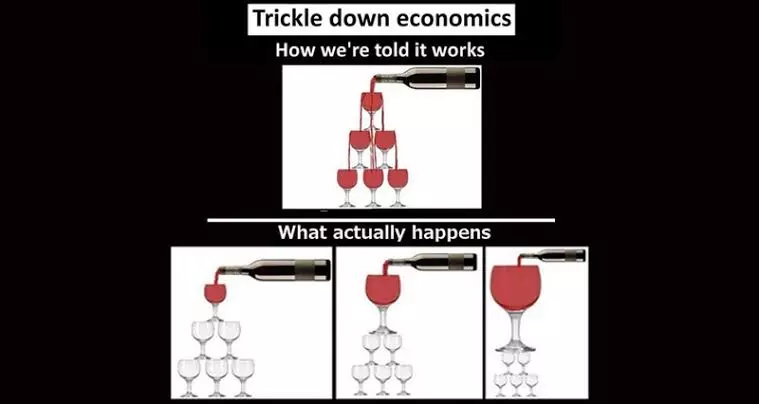Trickle-Down vs. Bottom-Up Economics: Why India Must Choose Inclusivity Over Elitism

India, a nation of immense diversity and untapped potential, is at a critical juncture in its economic trajectory. The country’s leaders must choose between two contrasting economic philosophies: the long-touted “trickle-down” approach, which assumes that benefits granted to the wealthy will eventually reach the poor, and the “bottom-up” model, which prioritizes the empowerment of the masses at the grassroots level. For a country plagued by staggering inequality and deep social divides, the bottom-up model is the only viable pathway to a truly inclusive and sustainable future.
Trickle-down economics, which has dominated India’s economic policies in recent years, is built on the assumption that creating wealth at the top will stimulate growth that will trickle down to lower-income groups. The BJP-led government has adopted this approach with policies favoring large corporations through dramatic corporate tax reductions, relaxed foreign investment norms, and privatization of public sector units. These measures are touted as necessary to spur investment and create jobs, but the evidence suggests otherwise. Between 2014 and 2019, while billionaires like Mukesh Ambani and Gautam Adani witnessed their wealth skyrocket by 188% and 121% respectively, the middle and lower-income groups saw their economic prospects shrink. Wealth concentration reached staggering levels, with the top 10% of Indians owning over 77% of the nation’s wealth, while the bottom 50% controlled a mere 13%.
Instead of spurring equitable growth, trickle-down policies have exacerbated inequality and perpetuated economic exclusion. The informal sector, which employs over 80% of India’s workforce, has been hit particularly hard by policies like demonetization and the Goods and Services Tax (GST). These measures disrupted livelihoods, eroded savings, and pushed millions into poverty. While large corporations flourished, small businesses and informal workers were left to fend for themselves in an increasingly hostile economic environment. Far from “trickling down,” wealth has been hoarded at the top, leaving a vast majority of Indians struggling to make ends meet.
In stark contrast, a bottom-up economic approach focuses on empowering the majority by directing investments and resources toward small businesses, rural communities, and marginalized populations. This model recognizes that true economic growth must be inclusive, creating opportunities for everyone to contribute to and benefit from the nation’s progress. For India, where a significant portion of the population depends on agriculture and informal work, and where regional inequalities persist, a bottom-up approach is not just a moral imperative but an economic necessity.
Investing in small-scale enterprises, rural industries, and self-help groups can uplift millions of people while stimulating local economies. Programs like MGNREGA, which guarantees rural employment, have already demonstrated the transformative power of grassroots interventions. By prioritizing such initiatives, India can tackle poverty head-on and lay the foundation for a more resilient and inclusive economy.
Women and marginalized communities stand to gain the most from a bottom-up model. These groups often bear the brunt of economic inequality, with limited access to education, healthcare, and employment opportunities. By directing resources toward their empowerment, India can ensure a more equitable distribution of wealth and create a workforce that is not only larger but also more skilled and diverse. This approach would unlock the full potential of the nation’s demographic dividend, turning its vast population into an asset rather than a liability.
Agriculture, the backbone of India’s economy, also stands to benefit from a bottom-up approach. Investing in irrigation, technology, and market linkages can transform the agricultural sector, ensuring fair prices for farmers and reducing the reliance on intermediaries. Diversifying rural livelihoods through initiatives that promote non-agricultural activities can create balanced regional development, reducing the strain on urban areas caused by mass migration.
The BJP government’s trickle-down strategy has failed to deliver on its promises, instead deepening economic disparities. Policies like the corporate tax cut of 2019, which reduced rates from 30% to 22%, have not spurred significant private investment or job creation. Instead, they have widened fiscal deficits, forcing cuts to critical welfare programs. Similarly, the electoral bonds scheme has institutionalized crony capitalism, allowing anonymous corporate donations to political parties and reinforcing a billionaire-dominated economy.
The consequences of these policies are visible in the growing economic uncertainty faced by middle and lower-income groups. The World Inequality Lab has labeled India a “Billionaire Raj,” noting that income inequality in the country is now worse than during British colonial rule. This concentration of wealth and power has eroded trust in democratic institutions and created a society that is increasingly divided along economic and social lines.
India must chart a new course, one that prioritizes the needs of its people over the profits of a few. The bottom-up model offers a blueprint for this transformation. By reinvigorating public investment in education, healthcare, and infrastructure, particularly in underserved rural areas, the government can create jobs, improve living standards, and foster human capital development. Supporting small and medium enterprises (SMEs) through access to affordable credit, simplified regulations, and digital infrastructure can empower local entrepreneurs and drive innovation.
Decentralization is another critical component of the bottom-up approach. Empowering local governments with greater financial autonomy and decision-making powers will enable more effective and context-specific interventions. Social safety nets, including universal basic income schemes and affordable housing programs, can provide economic stability to millions, reducing vulnerability to shocks and ensuring a minimum standard of living for all.
For a country as diverse and dynamic as India, the strength of the economy lies not in the wealth of its billionaires but in the well-being of its citizens. Trickle-down economics has proven to be a failed experiment, one that has enriched the few at the expense of the many. A bottom-up approach, grounded in inclusivity and empowerment, is the only path forward. It is time for India’s policymakers to recognize that economic progress must be measured not by GDP growth alone but by the dignity and opportunities afforded to every Indian.
By embracing a bottom-up model, India can build an economy that is not only more equitable but also more sustainable. For a nation that aspires to global leadership, true greatness lies in uplifting its poorest citizens and ensuring that every individual has a stake in its progress. The choice is clear: India must abandon the myth of trickle-down economics and commit to a future where growth begins at the grassroots.
